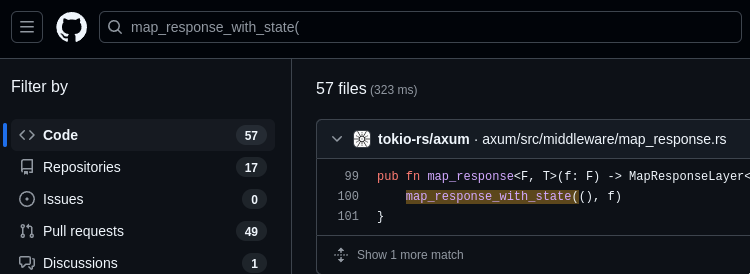Axum Ergonomics - HTML response middleware
.layer(map_response_with_state(app_state.clone(), with_template_response))
Why?
Developing a web application using Rust, Axum and Minijinja is fun and once the design and groundwork is laid it's quite easy, maintainable and performant. I'm not in any way an expert, continously finding new ways handle recurring issues and challenges.
Recently I took a gander on refactoring my growing application. With the amount of routes growing I took a look at simplifying the conversion of state into HTML. During this work I came across a quite enjoyable approach which I thought I'd share given my enjoyment of it, and that it it isn't too widely used, which prompted me writing this post.

Rendering
I'm using MiniJinja a templating engine which I highly recommend. I explored a couple (Askama, Tera) before settling on MiniJinja. Simplifying a bit, it uses Serde to serialize values and passes it to the templates which it then renders into HTML, which then the handler returns as a response to the request.
Middleware
Looking through the Axum documentation there is map_response_with_state(), which is a function to create a middleware that transforms the response sent from the handler. This means we can localize all HTML rendering to this middleware.
pub async fn with_template_response(
State(state): State<HtmlState>,
response: Response,
) -> Response {
// Clone the TemplateResponse from extensions
let template_response = response.extensions().get::<TemplateResponse>().cloned();
if let Some(template_response) = template_response {
TemplateStateWrapper {
state,
template_response,
}
.into_response()
} else {
response
}
}
Rusts type system makes it easy to check if the type matches our TemplateResponse type, and if it doesn't we just forward the response and do nothing with it. So in some instances I need to do stuff with the rendered response, like change headers, but for now its quite limited, the current approach allows me to just do .into_response() inside the handler and it will pass through the middleware with limited interference, mostly to see if the response matches the struct.
Error handling
Implementing error conversion also means we can use ? to propagate errors, and handle them in a fitting way.
impl From<surrealdb::Error> for HtmlError {
fn from(err: surrealdb::Error) -> Self {
HtmlError::AppError(AppError::from(err))
}
}
impl IntoResponse for HtmlError {
fn into_response(self) -> Response {
match self {
HtmlError::AppError(err) => {
let template_response = match err {
AppError::NotFound(_) => TemplateResponse::not_found(),
AppError::Auth(_) => TemplateResponse::unauthorized(),
AppError::Validation(msg) => TemplateResponse::bad_request(&msg),
_ => {
tracing::error!("Internal error: {:?}", err);
TemplateResponse::server_error()
}
};
template_response.into_response()
}
}
}
}
Wrapping it all together
This is an example of how a handler could look. Do note that there are other approaches that might be more concise for constructing the context than mine, but I enjoy being a bit strict and having a struct for passing the response, which helps when refactoring, catching errors that might occur when changing the data types returned from helper functions for example.
pub async fn show_text_content_edit_form(
State(state): State<HtmlState>,
RequireUser(user): RequireUser,
Path(id): Path<String>,
) -> Result<impl IntoResponse, HtmlError> {
let text_content = User::get_and_validate_text_content(&id, &user.id, &state.db).await?;
#[derive(Serialize)]
pub struct TextContentEditModalData {
pub user: User,
pub text_content: TextContent,
}
Ok(TemplateResponse::new_template(
"content/edit_text_content_modal.html",
TextContentEditModalData { user, text_content },
))
}
This post is not designed to be comprehensive or a detailed venture in to the considerations to be made about using it. But for me, it offered a fun approach, and I wanted to share it. If you got any questions or corrections to be made, please reach out by email.